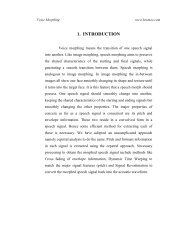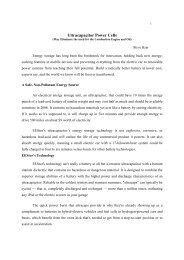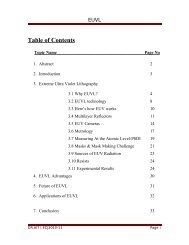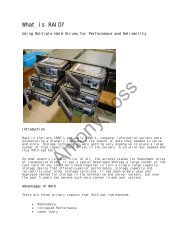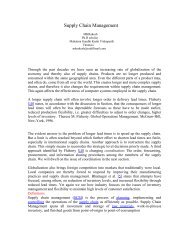Tele Immersion Full Seminar Report.pdf - 123SeminarsOnly
Tele Immersion Full Seminar Report.pdf - 123SeminarsOnly
Tele Immersion Full Seminar Report.pdf - 123SeminarsOnly
Create successful ePaper yourself
Turn your PDF publications into a flip-book with our unique Google optimized e-Paper software.
ABSTRACT<br />
<strong>Tele</strong>-immersion is an advanced<br />
form of virtual reality that will allow users in<br />
different places to interact in real time in a<br />
shared simulated environment. This<br />
technology causes users to feel as if they were<br />
in the same room. The tele-immersion<br />
technology uses a "tele-cubicle" which is<br />
equipped with large screens, scanners,<br />
sensors, and cameras. The tele-cubicles are<br />
linked together in real-time so that they form<br />
one larger cubicle. Through the virtual<br />
environment, participants are able to interact<br />
with other group members. Also, virtual<br />
objects and data can be passed through the<br />
walls between participants, and placed on the<br />
shared table in the middle for viewing. <strong>Tele</strong>immersion<br />
has the potential to significantly<br />
impact educational, scientific, manufacturing,<br />
and many other fields.<br />
• Interactive Scientific Visualization<br />
• Molecular Engineering<br />
• Virtual nuclear test.<br />
• Education and Training<br />
• Virtual classroom.<br />
TELE-IMMERSION<br />
• Army training.<br />
• Art and Entertainment.<br />
• Virtual game<br />
• Industrial Design,<br />
• Architectural Review and Evaluation<br />
• Remote design collaboration<br />
All of these researchers use Internet 2. Internet<br />
2 is the successor to the "commodity Internet",<br />
as the existing Internet is now known. Internet<br />
2 is a collaborative project, overseen by the<br />
University Corporation for Advanced Internet<br />
Development, and worked on by 130 US<br />
universities and a number of government<br />
agencies and corporate sponsors.<br />
TELE-IMMERSION<br />
You have a very important meeting<br />
with your business associates in Chennai.<br />
However you have visitors from Japan coming<br />
to ink a mega business deal the same day. So<br />
you go to a room you call the holodeck. There,<br />
inside a simulated environment, you contact<br />
your business associates using information<br />
technology. You are able to conduct a meeting<br />
with them almost as if you in Chennai. You<br />
even shake hands with their holographic<br />
images, because they seem to be right there!<br />
With tele-immersion you will interact<br />
instantly with your friend on the other side of<br />
the globe through a simulated holographic<br />
environment. This technology, which will<br />
come along with internet2, will change the<br />
way we work, study and get medical help. It<br />
will change the way we live.
1.INTRODUCTION<br />
<strong>Tele</strong>-immersion is a technology that<br />
will be implemented with internet2 it will<br />
enable users in different geographic locations<br />
to come together and interact in a simulated<br />
holographic environment. Users will feel as if<br />
they are actually looking, talking and meeting<br />
with each other face to face in the same place,<br />
even though they may be miles apart<br />
physically. In a tele-immersive environment,<br />
computer recognized the presence and<br />
movements of individuals as well as physical<br />
and virtual objects. They can then track these<br />
people and nonliving objects, and project them<br />
in a realistic way across many geographic<br />
locations.<br />
The three steps to constructing a<br />
holographic environment are:<br />
The computer recognizes the presence<br />
and movements of people and objects.<br />
The computer tracks those images.<br />
The computer projects those images on<br />
a strereoimmersive surface.<br />
3D reconstruction for tele-immersion is<br />
performed using stereo, which mean two or<br />
more cameras rapid sequential shots of the<br />
same objects, continuously performing<br />
distance calculations, and projecting them into<br />
the computer. Simulated environment to<br />
replicate real time movements. By combining<br />
cameras and Internet telephony, video<br />
conferencing has allowed real time exchange<br />
of more information than ever, without<br />
physically bringing each person into one<br />
central room.<br />
2.HISTORY<br />
It was way back in 1965 that the<br />
great pioneer of computer graphics, Ivan<br />
Sutherland, proposed the concept of the<br />
‘ultimate display’. It described a graphics<br />
display that would allow the user to<br />
experience a completely computer rendered<br />
environment.<br />
In 1998, Abilene, a backbone<br />
research project, was launched and now serves<br />
as a base for Internet2 research. Internet2<br />
needed an application that would challenge<br />
and stretch its networks’ capabilities. The<br />
head of advanced network and services<br />
proposed tele-immersion at the application<br />
that could drive internet2 research forward.<br />
That is how the national tele-immersion<br />
initiative as formed in may2000, researchers at<br />
the Universities of North Carolina (UNC), the<br />
Universities of Pennsylvania and advanced<br />
network and services reached a milestone in<br />
developing this technology. A user sitting in<br />
an office at UNC in Chapel Hill, NC, was able<br />
to see life like, 3D images of colleagues<br />
hundreds of miles away, one in Philadelphia<br />
and the other in New York. Today scientists<br />
are still developing this new communication<br />
technology. There are several groups working<br />
together on the national tele-immersion<br />
initiative (NTII) to make this wonderful<br />
technology available to the common men.<br />
3. COMPONENTS OF A<br />
HOLOGRAPHIC ENVIRONMENT<br />
<strong>Tele</strong>-immersive displays of earlier days<br />
required user to wear special goggles and a<br />
head device that tracked the view point of the<br />
user looking at the screen. At the other end,<br />
the people, who appeared as 3d image, where<br />
tracked with and array of 8 ordinary video<br />
cameras while three other video cameras<br />
captured real life patterns projected in each<br />
room to calculate distance. This enabled the<br />
proper depth to the recreated on the screen. So
if an observer move here head to the left, she<br />
could see the corresponding image that would<br />
be seen if she were actually in the room with<br />
the person on the screen.<br />
Views of cameras <strong>Tele</strong>immersed<br />
environment<br />
Scientists are developing new technologies<br />
support this type of communication. Apart of<br />
these new technologies is:<br />
<strong>Tele</strong>cubical :<br />
Users will communicate by using<br />
this technology. It consist of a Stereo<br />
immersive desk surface and two<br />
stereoimmersive wall surfaces. These three<br />
display surfaces join to form a virtual<br />
conference table in the centre. This will allow<br />
the realistic inclusion of tele-immersion into<br />
the work environment, as it will take up the<br />
usual amount of desk space.<br />
Internet2 :<br />
This will replace the current internet<br />
infrastructure. It is a consortium made up of<br />
the US government, industry and academia<br />
(180universities) that has been formed for<br />
creating tomorrow’s internet. This new<br />
network will have a higher bandwidth and<br />
speeds that are 1000 times faster than today’s<br />
internet. This high bandwidth, high speed<br />
network is necessary to transfer the large<br />
amounts of data that tele-immersion will<br />
produce.<br />
Bandwidth issues :<br />
Network bandwidth required to<br />
make tele-immersion work is one of the main<br />
concerns of this new technology. It is<br />
estimated that as much as 1.2 gigabits per sec<br />
will be needed for future high quality effects.<br />
This is much higher than the average home<br />
connection bandwidth. The exact amount of<br />
bandwidth needed for each scene depends on<br />
the complexity of the background. With time,<br />
the number of megabits used will fall as<br />
advanced compression techniques are<br />
established. Currently, the ‘last mile’ of<br />
network connections for top computer science<br />
departments in US use an OC3 line. This can<br />
carry 155 megabits per second and supports,<br />
at a basic level, a three way conversation.<br />
Although OC3 lines are 100 times faster than<br />
normal broadband, they are also more<br />
expensive.<br />
figure - Bandwidth over time –bandwidth<br />
utilization graph.
Initially, bandwidth-intensive<br />
application will have to be limited to the<br />
larger organizations that can afford high<br />
connection speeds. The amount of data sent to<br />
render this tele-presence will also require fast<br />
processing power. This will need to be<br />
available as required on the internet. A new<br />
network called the Grid could be a solution.<br />
The Grid will use distributed computing.<br />
There are not enough supercomputers to ideal<br />
with the enormous amount of data that will<br />
rush through the net in the future. As a<br />
solution, new network will connect their PCs<br />
so they can share processing power and hard<br />
disk space. They will be locked into a grideffectively<br />
creating one supercomputer.<br />
4. DISPLAY TECHNOLOGIES<br />
stereo immersive displays would have to<br />
present a clear view of the scenes being<br />
transmitted.<br />
Haptic sensors :<br />
would allow to touch projections as if they<br />
were real.<br />
Desktop supercomputers :<br />
would perform the trillions of calculations<br />
needed to create a holographic environment. A<br />
network of computers that share power could<br />
also possibly support these environments.<br />
5. HOW TELE-IMMERSION<br />
WORKS<br />
In this simplified scheme for how a<br />
future tele-immersion scheme might work,<br />
two partners separated by 1,000 miles<br />
collaborate on a new engine design.<br />
Following the flow of information<br />
tele-immersion depends on intense data<br />
processing at each end of a connection,<br />
mediated by high performance network.<br />
From the sender :<br />
Parallel processors accept visual<br />
inputs from the cameras and reinterpret the<br />
scene as a 3-Dimensional computer model.<br />
To the receiver :<br />
Specific rendering of remote<br />
people and places are synthesized from the<br />
model as it is received to match the point of<br />
view of each eye of a user. The whole<br />
process repeats many times a second to keep<br />
up with the user head motion<br />
Generating the 3-d image :
1.An array of cameras views people and<br />
their surroundings from different angle.<br />
Each camera generates an image from its<br />
point of view many times in a second.<br />
2. Each set of the images taken at a given<br />
instant is sorted into subsets of overlapping<br />
trios of images<br />
views taken by the cameras<br />
3 .From each trio of images, a “disparity map”<br />
is calculated, reflecting the degree of variation<br />
among the images at all points in the Disparity<br />
map visual field. The disparities are<br />
then analyzed to yield depths that would<br />
account for the differences between what each<br />
camera sees. These depth values are combined<br />
into a “bas relief” depth map of the scene.<br />
4. All the depth maps are combined into a<br />
single viewpoint independent sculptural<br />
model of the scene at a given moment. Process<br />
of combining the depth maps provide maps<br />
opportunities<br />
<strong>Tele</strong>-immersion and virtual reality :<br />
<strong>Tele</strong>-immersion may sound like<br />
virtual reality but there are major differences<br />
between the two technologies. While virtual<br />
reality allows you to move in a computergenerated<br />
3-D environment, tele-immersion<br />
can only create a 3d environment that you can<br />
see but not interact with. However, interaction<br />
is possible by combining the two technologies.<br />
6. APPLICATIONS<br />
<strong>Tele</strong>-immersive holographic<br />
environment have a number of applications.<br />
Imagine a video game free of joysticks, in<br />
which you become a participant in the game,<br />
fighting monsters or scoring touchdowns.<br />
Instead of traveling hundreds of miles to visit<br />
your relatives during the holidays, you can<br />
simply call them up and join them in a shared<br />
holographic room. Doctors and Soldiers could<br />
use tele-immersion to train in a simulated<br />
environment. Building inspectors could tour<br />
structures without living their desks.<br />
Automobile designers from different<br />
continents could meet to develop the next<br />
generation of vehicles. Surgeons indifferent<br />
geographical space could experiment with<br />
virtual medical procedures before working on<br />
actual patients. Medical technologies that are<br />
physically inaccessible in some places could<br />
be used to save lives by manipulating virtual<br />
models, instance, offshore oilrigs and ships. In<br />
the entertainment industry, ballroom dancers<br />
could train together from separate physical<br />
spaces.<br />
Instead of commuting to work for a<br />
board meeting, business persons could attend<br />
it by projecting themselves into the conference<br />
room. The list of
applications is large and varied, and one thing<br />
is crystal clear- this technology will<br />
significantly affect the educational, scientific<br />
and medical sectors.<br />
Medicine :<br />
<strong>Tele</strong>-immersion can be immense<br />
use the field of medicine. The way medicine is<br />
thought and practiced has always been very<br />
hands-on. It is impossible to treat a patient<br />
over the phone or give instructions for a<br />
tumour to be removed without physically<br />
being there. With the help of tele-immersion,<br />
3d surgical learning for virtual operation is<br />
now in place and, in the future, the hope is to<br />
be able to carry out real surgery on real<br />
patients. A geographically distanced surgeon<br />
could be tele-immersed into an operation<br />
theatre to perform an operation. This could<br />
patiently be life saving if the patient is in need<br />
of special care (either a technique or a piece of<br />
equipment), which is not available at the<br />
particular location.<br />
<strong>Tele</strong>-immersion ‘will give surgeons<br />
the ability to superimpose anatomic images<br />
rights on their patients will they are being<br />
operated on’. The argument against this is:<br />
how reliable is this technology? What would<br />
be the legal implication if the technology fails<br />
suddenly and the tele-immersed surgeon<br />
disappears in the middle of an operation, with<br />
the patient left without medical help? How<br />
accurate are the movements of the transported<br />
doctor when within an environment? Will the<br />
doctor be able to sense a patient’s mood and<br />
feelings? These are difficult questions to<br />
answer and there are bond to be many<br />
skeptics.<br />
Uses in Education :<br />
In education, tele-immersion can be<br />
used to bring together students at remote sites<br />
in a single environment relationship among<br />
educational institutions could improve<br />
tremendously in the future with the use of<br />
tele-immersion. Already, the academic world<br />
is sharing information on research and<br />
development to better the end results. <strong>Tele</strong>immersion<br />
will only promote this<br />
collaboration. This will be distinct advantage<br />
in surgical training. While it will not replace<br />
the hands on training, this technology will<br />
give surgeons a chance to learn complex<br />
situations before the treat their patients. With<br />
tele-immersion in schools, students could have<br />
access to data or control a telescope from a<br />
remote location, or meet the students from<br />
other countries by projecting themselves into a<br />
foreign space. Internet2 will provide access to<br />
digital libraries and labs, opening up the lines<br />
of communication for students. <strong>Tele</strong>immersion<br />
will bring to them place,<br />
equipment and situations earlier not available,<br />
helping them experience what they could have<br />
only watched, read or heard about earlier.<br />
Future office :<br />
In years to come, instead of asking<br />
for a colleague on the phone you will find it<br />
easier to instruct your computer to find him.<br />
Once you do that, you will probably see a<br />
flicker on one of your office walls and find<br />
that your colleague, who’s physically present<br />
in another city, is sitting right across you as if<br />
he is right there. The person at the other end<br />
will experience the same immersive<br />
connection. With the tele-immersion bringing<br />
two or more distant people together in a<br />
single, simulated office setting business travel<br />
will become quite redundant.
Video conferencing via internet is<br />
not a perfect form of communication. The<br />
image is closed to real time but there are<br />
delays that cause distorted video. Also, if<br />
someone walks out of the view of a camera<br />
the person is no longer visible. However, with<br />
tele-immersion, people will always remain in<br />
view of the camera and you will be able to<br />
look around their office just by looking at the<br />
display screen from different angles. <strong>Tele</strong>immersion<br />
takes video conferencing to a<br />
higher level it is a dynamic concept, which<br />
will transform the way humans interact with<br />
each other and the world in general.<br />
7. CONCLUSION<br />
When tele-immersion becomes<br />
commonplace, it will probably enable a wide<br />
variety of important applications. Teams of<br />
engineers might collaborate at great distances<br />
on computerized designs for new machines<br />
that can be tinkered with as though they were<br />
real models on a shared workbench.<br />
Archaeologists from around the world might<br />
experience being present during a crucial dig.<br />
Rarefied experts in building inspection or<br />
engine repair might be able to visit locations<br />
without losing time to air travel.<br />
In fact, tele-immersion might come<br />
to be seen as real competition for air travel-unlike<br />
videoconferencing. Although few<br />
would claim that tele-immersion will be<br />
absolutely as good as "being there" in the near<br />
term, it might be good enough for business<br />
meetings, professional consultations, training<br />
sessions, trade show exhibits and the like.<br />
Business travel might be replaced to a<br />
significant degree by tele-immersion in 10<br />
years. This is not only because tele-immersion<br />
will become better and cheaper but because air<br />
travel will face limits to growth because of<br />
safety, land use and environmental concerns.<br />
Undoubtedly tele-immersion will<br />
pose new challenges as well. Some early users<br />
have expressed a concern that tele-immersion<br />
exposes too much, that telephones and<br />
videoconferencing tools make it easier for<br />
participants to control their exposure--to put<br />
the phone down or move off-screen. We are<br />
hopeful that with experience we will discover<br />
both user-interface designs and conventions of<br />
behavior that address such potential problems.<br />
8. REFERENCES<br />
• American Scientist magazine issue<br />
April 2001.<br />
• Information Technology magazine<br />
August 2003.<br />
• GRID Today magazine issue<br />
December 2002.



